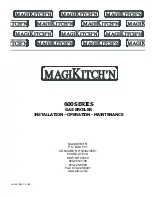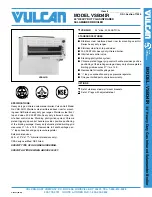
User’s manual
Technical staff manual
6.
OPERATIONS BEFORE INSTALLATION
CAUTION! Boiler installation, putting the boiler into operation and technical service can be effectuated
only by a specialized service organization. Boiler installation must be effectuated according to the
project which complies with the requirements of Federal and local normative acts, regulating gas
appliances installation.
The boiler is designed for heating water to the temperature lower than the boiling point at atmospheric
pressure.
The boiler should be connected to the heating system, and also to the water supply network in order to receive
domestic hot water for housekeeping needs (hereinafter referred to as DHW), and after that to the gas pipeline.
Heating and water supply systems must be compatible with the boiler’s exploitation characteristics and power.
Boiler’s technical characteristics are represented in p.2.2. (page 5).
Before putting the boiler into operation it is necessary to effect the following:
-To check the compliance of the type of gas and pressure indicated in the sections 20 and 21 (page 40) and in
the table o the boiler with the used type of gas and gas pressure in the place of the boiler’s installation. In case
of non-compliance it is necessary to render the boiler to the used type of gas and pressure in accordance with
section 12 (page23);
-To make sure that the installation was correct and the smoke exhauster is airtight;
-In order to provide correct boiler operation ant to keep the warranty it is necessary to follow the requirements
of this manual.
7.1 DHW System
For normal boiler operation it is necessary to install a water filter before the boiler on the DHW line.
If water hardness exceeds 200 mg of calcium carbonate per 1 liter water, it is necessary to install a
polyphosphates dose meter or another water softening device.
7.2. Heating system
The boiler is connected to the heating system and hot water supply system (DHW), in accordance with
its characteristics and heating power.
Minimal heat output of the heating system must be more than 8,9 kWt. Otherwise, the boiler will
operate unstably, what would lead to reduction of its working lifespan.
Water chemical makeup requirements are indicated in section 10 (page 19).
Presence of rust, dirt and other depositions in the heating system leads to the boiler’s operation disturbance
and performance degradation (overheating, noise in the heat exchanger, heating effect reduction). In
connection to this, the heating system must be washed before the boiler’s installation.
For this acid and alkaline-based detergents or detergents, corroding metal, plastic and rubber parts of the
boiler, cannot be used.
It is recommended to use SENTINEL X400 и SENTINEL X100. The purchased heating system cleaning
detergent must be used in accordance with the instruction attached to it.
7.2.1 New heating system
The new heating system, before connecting it to the boiler must be cleaned from shavings, welding lubrication
burr and other undesirable materials that may have got inside of it at installation, using appropriate means for
it.
7.2.2. Existing heating system
The existing heating system must be cleaned from accumulated dirt, rust and scale deposits, using appropriate
means for it.
7.3. Selection of an additional expansion tank
The membrane type expansion tank, installed into the boiler is designed for connection of the boiler to the
heating system with a capacity of not more than 70 liters. If the boiler is connected to the heating system with
bigger water volume, it is necessary to install and additional membrane expansion tank. Indications on
selection of an additional membrane tank are represented in Annex II (page51).
Technical staff manual
8.
BOILER INSTALLATION
8.1.
Mounting the boiler to the wall
-The boiler must be installed in kitchens or other non-living heated premises in accordance with the gasification
project, the set of rules SP 62.13330.2011, SP 41−108−2004 and Regulations of fire safety of Russian Federation(PPB
01−03);
- in accordance with p. 4.2.7, 4.2.10 and 4.2.11 SP 41−108−2004 the boiler installation should be provided in the
following conditions:
- On the walls made from non-flammable (NG) or low-flammable (G1) materials;
-On the walls covered by non-flammable (RG) or low-flammable (G1) materials (for example roofing steel on a sheet
of heat-insulating layer of non-flammable materials not less than 3 mm thick; lime plaster not less than 10 mm thick)















































